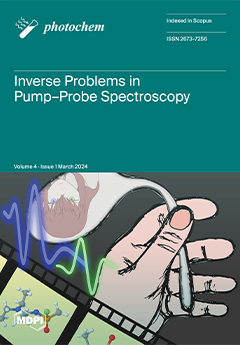Fluorescence from dialkylamino donor–acyl acceptor substituted 1,8-naphthalene derivatives can occur either from a planar (PICT) or a twisted (TICT) intramolecular charge transfer excited state. The photophysical properties of 8-acetyl-1-(dimethyl-amino)naphthalene (
3) and 8-pivaloyl-1-(dimethyl-amino)naphthalene (
4) are compared with 1-methyl-2,3-dihydronaphtho[1,8-bc]azepin-4(1H)-one (
5
[...] Read more.
Fluorescence from dialkylamino donor–acyl acceptor substituted 1,8-naphthalene derivatives can occur either from a planar (PICT) or a twisted (TICT) intramolecular charge transfer excited state. The photophysical properties of 8-acetyl-1-(dimethyl-amino)naphthalene (
3) and 8-pivaloyl-1-(dimethyl-amino)naphthalene (
4) are compared with 1-methyl-2,3-dihydronaphtho[1,8-bc]azepin-4(1H)-one (
5). In
3 and
4, both the carbonyl and amino groups are forced to twist out of the plane of the naphthalene ring. In
5, these groups are nearly coplanar with the naphthalene. Neither
3 nor
4 fluoresce as strongly as
5, but all three show similar degrees of solvato-chromism and all are strongly quenched by alcohol solvents. Nitrile
6, 8-cyano-1-(dimethyl-amino)naphthalene, does not show the same degree of solvato-chromism as
3–
5, nor is it as affected by alcohols. Calculations corroborate the experimental results, indicating that
3–
5 emit from a PICT excited state.
Full article





